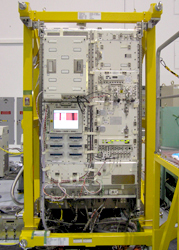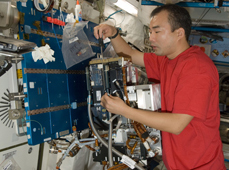Q. What kind of materials science experiments have been conducted on Kibo so far?
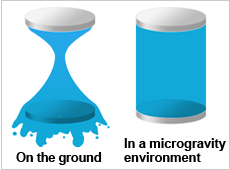
Liquid flows out from between the two disks on the ground, but forms a bridge in space
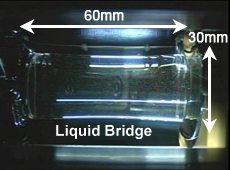
Largest liquid bridge formed in the Marangoni convection experiment (courtesy: JAXA/Tokyo University of Science, Suwa)
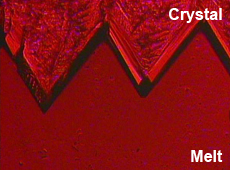
Crystal growth in the FACET experiment
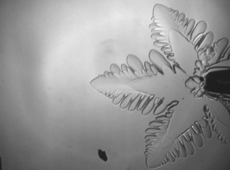
Ice crystal growth experiment (courtesy: JAXA/Hokkaido University)
So far, we’ve performed three experiments, to study the Marangoni effect, faceted crystal growth, and ice crystal growth. These experiments are still under analysis, so I cannot talk about the results here, but let me explain each experiment.
First of all, for the Marangoni experiment, we form a liquid bridge of silicone oil sandwiched between two disks. If we ran this experiment on the ground, the silicon oil would flow away as the spacing between the two disks increased. However, in the microgravity environment of space, liquid is able to form a stable bridge. With the experiment on Kibo, we have achieved the world’s largest liquid bridge, 30 millimeters in diameter x 60 millimeters in length. When one of the disks is heated, the resultant difference in temperature causes a difference in surface tension, which generates Marangoni convection. Then, we closely monitor the shape, the internal current flow, and the temperature distribution on the liquid bridge. Various types of data are collected as we change the conditions - for example, the temperature of the heating disk. This experiment has been ongoing since August 2008, and is currently being led by Prof. Koichi Nishino of National Yokohama University, and his colleagues.
The goal of the facet experiment is to understand how a crystal with flat facets grows by dividing, in small increments, much like cell division. Facets can be seen in a raw material such as polycrystalline silicon, which is used in solar panels. The problem is that it is easy for crystals to form defects or take in impurities while new facets are forming on their surface. It has not yet been understood what triggers the formation of a new facet, and why the quality of the crystal degrades during the process. In 2009, 40 crystal growth experiments were carried out, and an extremely beautiful crystal, something that nobody has ever seen on the ground, was observed. I was very moved when I saw mountains forming on facets and starting to grow into a flat and perfect saw-tooth pattern. Another experiment is scheduled for this September to obtain even more sophisticated data.
The ice crystal experiment is led by Prof. Yoshinori Furukawa of Hokkaido University. Ice crystals look like tree branches, so they are called dendritic crystals. A dendritic ice crystal has a hexagonal shape, but at its inception it is disk-shaped, so why does it develop six branches as it grows? This process has not yet been explained. Some metals and alloys also form dendritic crystals, so understanding the onset of dendritic crystal formation on ice can provides us with necessary information to improve materials processing in industry. In the Kibo experiment, ice crystals were formed in the convection-free environment. More than 130 experiments were performed over the course of three months starting December 2008, and beautiful and symmetric ice crystals were observed. On the ground, gravity impacts the speed and direction of growth of the six branches of an ice crystal, but the branches of space-grown ice crystals developed very homogeneously at similar speeds. Q. What are your impressions from these experiments on Kibo? While experiments on the Space Shuttle are given a time frame of only a few weeks, the great merit of performing experiments on Kibo is to be able to take our time. As long as time allows, you can perform the same experiment repeatedly to acquire more reliable data.
For instance, when a Marangoni convection experiment is performed on the ground, drop towers or aircrafts have been used to obtain a weightless environment. However, such experiments cannot last more than a few minutes, which is too short for convection to begin and settle. In such circumstances, you cannot expect accurate experimental data. But on Kibo, there is no need to rush. You have abundant time. You can afford to conduct an experiment once a week, analyze the data, and then try to reproduce the results to ensure its credibility. And while you’re performing one experiment, you can come up with ideas for the next. We now have come to a point where we can apply similar methods and frequencies for space-based experiments on Kibo as was formerly possible only on the ground.I think it is a great achievement that, by carrying out space-based experiments, we have confirmed our hypotheses that certain phenomena are indeed caused by convection generated by gravity.
In general, research begins with precise observation. So I am very glad that I was able to witness and confirm the process of crystal formation in the convection-free environment. As we continue to carry out many different experiments, we might run into a case where something we thought was caused by gravity actually is not. If so, there is something fundamental we do not know about in the mechanisms of crystal growth, and an attempt to understand it moves to the top of the research agenda. I think this is how our never-ending spirit of inquiry works.

